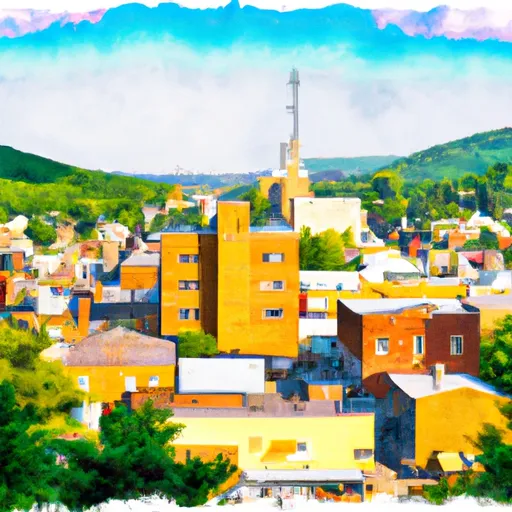-
 Snoflo Premium
Snoflo Premium
Get unlimited access to all our content
With no Ad interruptions! - Start Your Free Trial Login with existing account
Waynesburg
Eden Index
Climate
8.1
•
Recreation
3.1
•
Community
2.9
•
Safeguard
5.0/10

Waynesburg, Pennsylvania is a small borough located in Greene County. It experiences a humid continental climate, characterized by warm summers and cold winters. Average temperatures range from the mid-20s°F (-4°C) in winter to the mid-80s°F (30°C) in summer. Precipitation is evenly distributed throughout the year, with an annual average of around 40 inches (1016 mm).
The hydrology constituents in Waynesburg include the nearby Monongahela River and its tributaries. These water bodies provide opportunities for activities such as fishing, boating, and kayaking. The area is known for its abundance of smallmouth bass, walleye, and catfish.
Outdoor enthusiasts can explore various recreation opportunities in Waynesburg and its surrounding areas. Ryerson Station State Park, located nearby, offers hiking trails, picnicking spots, and a 62-acre lake for fishing and boating. Greene River Trail, a scenic 5.7-mile (9.2 km) trail, is popular among walkers, joggers, and bikers. Additionally, local parks and forests provide opportunities for camping, birdwatching, and exploring nature.
Overall, Waynesburg, Pennsylvania offers a pleasant climate, diverse hydrological features, and a range of outdoor recreation opportunities for residents and visitors alike.
What is the Eden Index?
The Snoflo Eden Index serves as a comprehensive rating system for regions, evaluating their desirability through a holistic assessment of climate health, outdoor recreation opportunities, and natural disaster risk, acknowledging the profound impact of these factors on livability and well-being.
Climate Health Indicator (CHI): 8.1
Waynesburg receives approximately
1046mm of rain per year,
with humidity levels near 83%
and air temperatures averaging around
11°C.
Waynesburg has a plant hardyness factor of
6, meaning
plants and agriculture in this region thrive during a short period during spring and early summer. Most
plants will die off during the colder winter months.
By considering the ideal temperature range, reliable water supplies, clean air, and stable seasonal rain or snowpacks, the Climate Health Indicator (CHI) underscores the significance of a healthy climate as the foundation for quality living.
A healthy climate is paramount for ensuring a high quality of life and livability in a region, fostering both physical well-being and environmental harmony. This can be characterized by ideal temperatures, reliable access to water supplies, clean air, and consistent seasonal rain or snowpacks.
Weather Forecast
Streamflow Conditions
Monongahela
Area Rivers
Monongahela
Snowpack Depths
Monongahela
Reservoir Storage Capacity
Monongahela
Groundwater Levels
Recreational Opportunity Index (ROI): 3.1
The Recreational Opportunity Index (ROI) recognizes the value of outdoor recreational options, such as parks, hiking trails, camping sites, and fishing spots, while acknowledging that climate plays a pivotal role in ensuring the comfort and consistency of these experiences.
Access to outdoor recreational opportunities, encompassing activities such as parks, hiking, camping, and fishing, is crucial for overall well-being, and the climate plays a pivotal role in enabling and enhancing these experiences, ensuring that individuals can engage in nature-based activities comfortably and consistently.
Camping Areas
| Campground | Campsites | Reservations | Toilets | Showers | Elevation |
|---|---|---|---|---|---|
| Kumbrabow State Forest | None | 3,006 ft | |||
| Holly River State Park | None | 1,695 ft | |||
| Audra State Park | None | 1,733 ft | |||
| Mason - Dixon Historical Park | None | 1,170 ft | |||
| Tygart Lake State Park | None | 1,516 ft |
Nearby Ski Areas
Catastrophe Safeguard Index (CSI):
The Catastrophe Safeguard Index (CSI) recognizes that natural disaster risk, encompassing floods, fires, hurricanes, and tornadoes, can drastically affect safety and the overall appeal of an area.
The level of natural disaster risk in a region significantly affects safety and the overall livability, with climate change amplifying these risks by potentially increasing the frequency and intensity of events like floods, fires, hurricanes, and tornadoes, thereby posing substantial challenges to community resilience and well-being.
Community Resilience Indicator (CRI): 2.9
The Community Resilience Indicator (CRI) recognizes that education, healthcare, and socioeconomics are crucial to the well-being of a region. The CRI acknowledges the profound impact of these elements on residents' overall quality of life. By evaluating educational resources, healthcare accessibility, and economic inclusivity, the index captures the essential aspects that contribute to a thriving community, fostering resident satisfaction, equity, and social cohesion.

